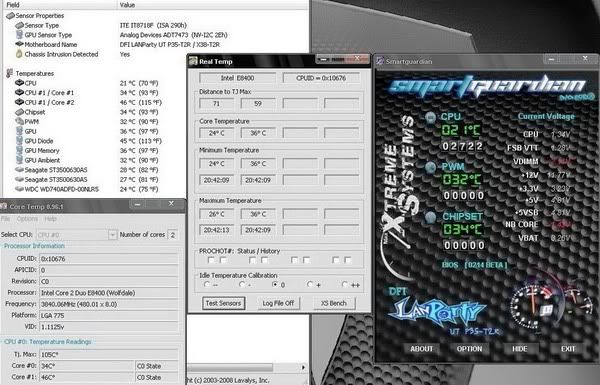Some feedback for unclewebb on RealTemp from an AT user:
"I do not have a E8xxx but have a E6400 L2. He also used this CPU as a comparison.
It seems Real Temp thinks my CPU has a Tjmax of 85C and not 100C.
Everything I have read says the E6400 has a Tjmax of 100C.
Now E6400's in general seem to run hotter than say a E6300 at the same clock speed and voltage. Both CPU's have a TJmax of 100C as far as I can tell.
This has always bugged me. Something is not being accounted for.
I have checked and calibrated speedfan's reported Tcase and Tjunction temps using Computronix Guide here. http://www.ocforums.com/showthread.php?t=543522
Now this guide could be all wrong but it seems to make logical sense and the results make sense. Tcase calibration would seem to be almost infallible IMO, at least then the CPU is at idle. Tjunction temps are a gray area do to Intel not releasing compete info.
Now I believe I can trust the Tcase temp reported by Speedfan at idle for sure because of the method of calibration in Computronix guide. Load temps are more questionable because there is no easy way to check accuracy. I'm not using a Nvidia based mother board which is known to report Tcase temp in a non linear way. So I'm going to just trust Tcase temps reported by Speedfan to be accurate. I also believe Tcase to Tjunction delta's on E6400's are 15C +-3C as the guide claims. Now Real Temp set to ++ as Unclewebb recommends on a E6400 reports Tjunction temps way to close to speedfans reported Tcase temp at idle IMO. Now Unclewebb claims E6400 CPU's under report Tjunction temps at idle but using Real Temp set as he specifies for a E6400 reports lower Tjunction temps than any other program. Speedfan (calibrated), Coretemp, HWmonitor etc. I just feel something is wrong here.
Looking at load temps Real Temp reports Tjunction temps lower than Speedfan reports Tcase temp. This is not possible so one or the other is wrong. I still wonder what the true Tjmax temp is on a E6400 really is? Load temps sure look nice using Real Temp compared to other programs but something just does not fell right.
Some screen shots, right click and choose view it they are hard to read.
Idle
http://i156.photobucket.com/al...erwrench/Misc/Idle.png
Load
http://i156.photobucket.com/al...wrench/Misc/load-1.png
In the end I say not enough is known about Intel's Core2 CPU's to be able to trust temps reported by any method. I think Unclewebb is on to something but too many pieces of the puzzle are still missing."




 Reply With Quote
Reply With Quote















 ..& the minimize to tray functionality would be icing on this cake
..& the minimize to tray functionality would be icing on this cake 










Bookmarks